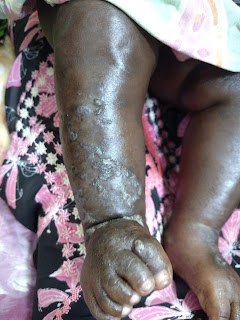I was hoping to have some input on this case.The patient is an 11 month old female infant born via spontaneous vaginal delivery, to a G1P1 mom (young, but not sure of mothers age). No reported maternal history of perinatal infections. TORCH screening performed on the child during this admission is negative. The child has bilateral retinal detachment, but her hearing is retained. She has gross developmental delay, and the rash you see in the photos started after birth on the R forearm, and has migrated since to all areas of the body, including the chest, back, yo the upper and lower extremities, and scalp. Her mother states the rash begins as blisters (second photo), which then open (no drainage noted per mom) and leave areas of hypopigmentation (third photo) and finally hyper-pigmentation (first photo).
The child does not seem bothered by this rash, it is not pruritic, and she does not have any fevers. Despite negative TORCH screening, I'm still thinking along the lines of a congenital-type of disease. Your thoughts would be greatly appreciated!
Dr. Yoon Cohen wrote:
The clinical description and the images seems to go with incontinentia pigmenti in this her 11 month infant girl.
For management, the skin changes of IP usually do not requires any specific treatment other than wound care for blisters to prevent secondary skin infection. The baseline eye exam and close follow up by an ophthalmologist will be important, especially with her retinal detachment history. Neurological evaluation should be done for potential seizures, encephalopathy and ischemic stroke. Dental evaluation is recommended after teeth erupt for pegged or missing teeth. Other ectodermal abnormalities can be seen as alopecia and nail dystrophy. In countries with more resources, this infant would benefit from being seen at a center where the pediatric dermatologists have more experienc with genodermatoses.
References:
1. I.P. NORD site.
2. I.P. GARG (NIH Genetic and Rare Diseases information site)
3. I.P. World Community (some parts in French)



No comments:
Post a Comment
We welcome your comments. We endeavor to serve your patients and you. If you want us to respond, please add your name and email address. Some people have trouble uploading comments. In that case, please send comments directly to djelpern@gmail.com. Thank you.